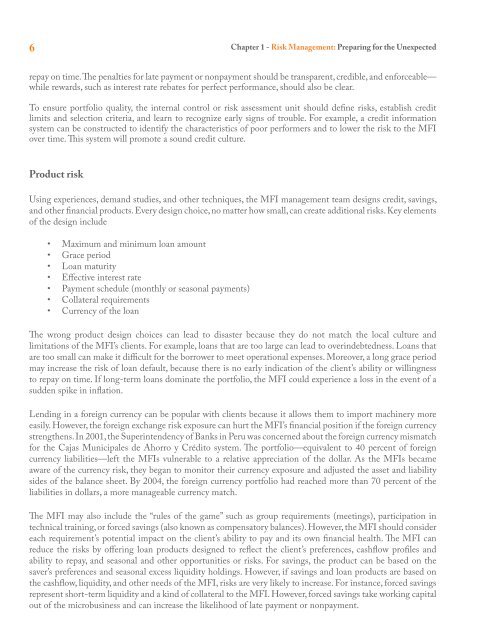managing risk.pdf
managing risk.pdf
managing risk.pdf
Create successful ePaper yourself
Turn your PDF publications into a flip-book with our unique Google optimized e-Paper software.
6 Chapter 1 - Risk Management: Preparing for the Unexpectedrepay on time. The penalties for late payment or nonpayment should be transparent, credible, and enforceable—while rewards, such as interest rate rebates for perfect performance, should also be clear.To ensure portfolio quality, the internal control or <strong>risk</strong> assessment unit should define <strong>risk</strong>s, establish creditlimits and selection criteria, and learn to recognize early signs of trouble. For example, a credit informationsystem can be constructed to identify the characteristics of poor performers and to lower the <strong>risk</strong> to the MFIover time. This system will promote a sound credit culture.Product <strong>risk</strong>Using experiences, demand studies, and other techniques, the MFI management team designs credit, savings,and other financial products. Every design choice, no matter how small, can create additional <strong>risk</strong>s. Key elementsof the design include• Maximum and minimum loan amount• Grace period• Loan maturity• Effective interest rate• Payment schedule (monthly or seasonal payments)• Collateral requirements• Currency of the loanThe wrong product design choices can lead to disaster because they do not match the local culture andlimitations of the MFI’s clients. For example, loans that are too large can lead to overindebtedness. Loans thatare too small can make it difficult for the borrower to meet operational expenses. Moreover, a long grace periodmay increase the <strong>risk</strong> of loan default, because there is no early indication of the client’s ability or willingnessto repay on time. If long-term loans dominate the portfolio, the MFI could experience a loss in the event of asudden spike in inflation.Lending in a foreign currency can be popular with clients because it allows them to import machinery moreeasily. However, the foreign exchange <strong>risk</strong> exposure can hurt the MFI’s financial position if the foreign currencystrengthens. In 2001, the Superintendency of Banks in Peru was concerned about the foreign currency mismatchfor the Cajas Municipales de Ahorro y Crédito system. The portfolio—equivalent to 40 percent of foreigncurrency liabilities—left the MFIs vulnerable to a relative appreciation of the dollar. As the MFIs becameaware of the currency <strong>risk</strong>, they began to monitor their currency exposure and adjusted the asset and liabilitysides of the balance sheet. By 2004, the foreign currency portfolio had reached more than 70 percent of theliabilities in dollars, a more manageable currency match.The MFI may also include the “rules of the game” such as group requirements (meetings), participation intechnical training, or forced savings (also known as compensatory balances). However, the MFI should considereach requirement’s potential impact on the client’s ability to pay and its own financial health. The MFI canreduce the <strong>risk</strong>s by offering loan products designed to reflect the client’s preferences, cashflow profiles andability to repay, and seasonal and other opportunities or <strong>risk</strong>s. For savings, the product can be based on thesaver’s preferences and seasonal excess liquidity holdings. However, if savings and loan products are based onthe cashflow, liquidity, and other needs of the MFI, <strong>risk</strong>s are very likely to increase. For instance, forced savingsrepresent short-term liquidity and a kind of collateral to the MFI. However, forced savings take working capitalout of the microbusiness and can increase the likelihood of late payment or nonpayment.
















